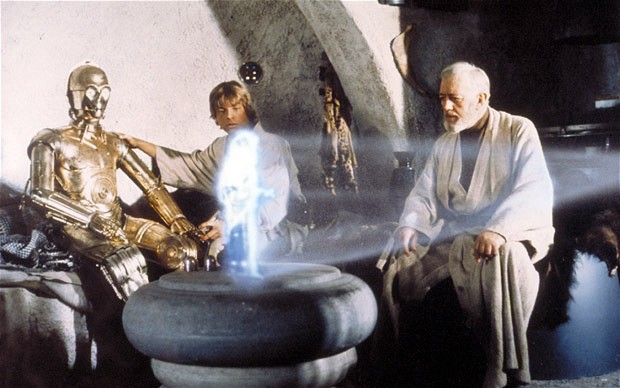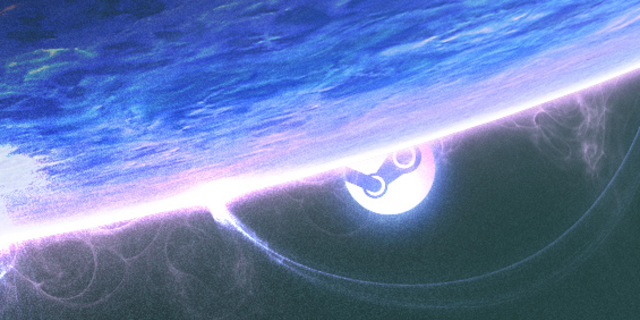A Hologram Or Other Reasonable Facsimile
[Main image: STAR WARS/Lucasfilm Ltd.]
There are a lot of highly versatile pieces of technology in science fiction. But none can have people standing beside themselves (rimshot) like holographic technology. We’re not exactly to the point of holodecks or telling Obi Wan Kenobi that he’s our only hope. But there is a bit of advancing science that brings us a step or two closer.
First, let’s consider what makes a hologram. A hologram is a 3D virtual image which is seen or perceived without an actual physical object being present. This requires directing light separately to each eye. This is not something that is easy to do. Whether that image comes from a flat surface or in a 3D display, each eye must be targeted individually. There are a variety of ways in which it can be accomplished. Let’s look at a few of these, as well as what it would take to make a real-world hologram straight out of science fiction.
3D Graphics
Stereo photography has been around almost as long as photography itself. Two images are taken side by side, and the results are viewed through two lenses which produce a 3D image. Most of us grew up with the disk-based View-Master toy. It was fun to see real-world landmarks without actually seeing them in the real world. And no matter how many times those pictures were viewed, it never seemed to get old.

Based on the same concept of stereo graphics, 3D movies have been around since the 1950s. So this should be something familiar to almost everyone. It began with one type of passive 3D technology using those stylish paper glasses with the red and blue plastic “lenses”. It later grew into the stylish paper glasses with the red and … um … cyan plastic “lenses”. There are also other usable (and occasionally used) stylishly tacky color combinations. For example, there’s red and green, blue and orange, and purple/violet and amber/yellow. They work on the additive color spectrum (red, green and blue make white). By stacking two colored images on top of each other, one right eye and one left eye, the incorrect image for that eye would be blocked out. It works great for black-and-white images, but not as well for color, though that doesn’t seem to stop anyone from trying.
Then comes passive polarization. To get an idea of how polarization works, take two fine-toothed combs and put them together. (It works best when the teeth are not the same size between the combs.) When held in a cross pattern (in a “+” shape), you can see through it. It may not be the best image, but you can still see through. Now turn them so that they’re right together (in a “-” shape). Now one interferes with the other, and it’s a bit difficult to see what’s on the other side. This is the way polarization works. One image is polarized one way and one is polarized the other way. Then each of the “lenses” filters out the image which is incorrect for that eye. It allows for full 3D imagery without making the colors look like crap. The classic version is one eye polarized vertically and one horizontally. Some are polarized diagonally, one slanted right and the other slanted left. The other option is circular (spiral) where one is polarized in a clockwise spiral and the other in a counter-clockwise spiral.
More modern technology (especially on so-called 3D televisions) uses active 3D using much uglier glasses with active technology where each eye has a shutter. The shutters alternate, synchronized to the images on the television set. As long as you have several grand burning a hole in your pocket that you’re willing to part with over and above the regular cost of a regular flat screen television, you can wear glasses that make you look like a complete dork while getting a cheap thrill from the tiny handful of channels that actually use the technology.
Autostereoscopy
Then there’s 3D imaging without the need for special glasses. This is called autostereoscopy. It provides all the thrills of 3D without the ugly glasses. There are currently two main ways in which this is done. The first is called a parallax barrier. It consists of a screen with a filter placed on top. That filter has very small and precise slits which help direct light to the right and left eyes separately. This is what one would be looking at on a Nintendo 3DS handheld game console. The parallax barrier reduces the amount of light but still produces a fairly believable 3D display.
The other is by way of a lenticular array. This is done with cylindrical lensing which directs light without blocking any out. This is used on toys as well as book and DVD covers to create a 3D image or an image which changes when seen from a slightly different angle. It is also being used to make newer 3D televisions which don’t require goofy glasses in order to enjoy.
Holography
Back in the 1980s, one type of technology made a splash when it graced the cover of National Geographic. It’s realistic 3D which is seen in rainbow colors. It’s called holography. Holography is done when an object has its picture taken using lasers and mirrors, and a specially sensitive photographic plate. This is the type of hologram used on credit cards and other forms of identification in order to insure their authenticity. They’re also used on a lot of product packaging. But it’s become so commonplace that people hardly ever pay attention to the fact that it’s there.
[vimeo http://www.vimeo.com/40540327 w=400&h=300]
Holographic Projection
And then there’s the Musion Eyeliner technology. This is what made a splash on the Interwebz with the “hologram” of the late Tupac Shakur. Actually, it’s not exactly a hologram per se. It’s a projection using the Pepper’s Ghost technique from the 19th century. In this magician’s trick, an image can be reflected onto a clear piece of glass creating a ghostly image. But it actually makes for a great example of what one might consider to be a true modern day hologram. Well, it’s closer anyway.
Volumetric Displays
Okay, now we’re getting somewhere. Or maybe we’re not, depending on your perspective. There are several attempts at a “floating in midair” displays, each with varying levels of effectiveness. One is using a clear display medium where the individual points are “activated” by intersecting lasers of the correct frequencies, forming points of glowing plasma in a particular shape. A non-visible gas or plasma volume could help explain some of the holograms in Star Wars.
Another method is the fog method. It’s somewhat similar to the previous method in which it uses a gaseous volume as a projection surface. Unfortunately, it’s just a projection surface and a projector, but not a true hologram.
Then there’s the “swept volume” display. It involves a clear surface moving rapidly back and forth drawing “slices” of an image so quickly that it looks like one continuous image. While it produces a neat 3D image, it’s hardly something that can clutter the air in Tony Stark’s workshop.
Augmented Reality
Holograms have one major inherent problem. It’s difficult to get a photon beam to stop in one point where it explodes in all directions so everyone can see it, let alone to get a whole bunch of them to do it in a synchronized pattern which can form a recognizable object, without having some sort of physical medium in which to project it. We certainly don’t have the force fields and replicators to perform like a Star Trek holodeck. So what in current technology can make such 3D illusions? Until we have some new scientific discoveries in the field of optical physics, we’ll just have to settle for augmented reality.
Augmented reality is a relatively new concept currently adapted into smart phones. In South Korea, it’s used to identify the names and info about certain locations based on the image scanned by the phone’s camera. The information is overlaid on the picture of the buildings on the screen. In the US, it can be used to make characters on the covers of comic books talk. Microvision has laser technology which projects images onto the lens of a pair of glasses. One day, micronized heads-up displays can be shrunk down to contact lenses. Apple Computers once experimented with using lasers to project images directly onto a person’s retinas without setting the retinas on fire or causing other permanent damage.
With this kind of display, everyone who is using the technology would be able to see the overlaid 3D images. Then the true holographic effect we’ve all grown to know and love on the silver screen might have a chance of coming to life.
While it’s not exactly the floating image that one would expect a hologram to be, the augmented reality could hold the key to making the perception of such an image possible. Not just any image, but one which would have you standing beside yourself … or at least a reasonable facsimile of yourself.
![]()








Reblogged this on Daniel C. Handley and commented:
Written for SciFi4Me.com